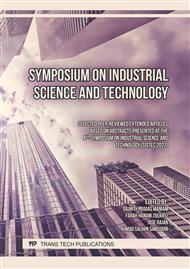[1]
W.N.Z.L.W. Jusoh, M.S. Sajab, P.M. Abdul, H. Kaco. Recent Advances in 3D Bioprinting: A Review of Cellulose-Based Biomaterials Ink. Polymers. 14 (2022) 1260-1285.
DOI: 10.3390/polym14112260
Google Scholar
[2]
F.R. Beltrán, M.P. Arrieta, E. Moreno, G. Gaspar, L.M. Muneta, R. Carrasco-Gallego, S. Yáñez D. Hidalgo-Carvajal, M.U. de la Orden, J.M. Urreaga. Evaluation of the Technical Viability of Distributed Mechanical Recycling of PLA 3D Printing Wastes. Polymers. 13 (2021) 1247-1268.
DOI: 10.3390/polym13081247
Google Scholar
[3]
E. Moreno, F.R. Beltrán, M.P. Arrieta, G. Gaspar, L.M. Muneta, R. Carrasco-Gallego, S. Yáñez D. Hidalgo-Carvajal, M.U. de la Orden, J.M. Urreaga. Technical Evaluation of Mechanical Recycling of PLA 3D Printing Wastes. Proceedings. 69 (2021) 19-24.
DOI: 10.3390/polym13081247
Google Scholar
[4]
D.D. Silva, M. Kaduri, M. Poley, O. Adir, N. Krinsky, J. Shainsky-Roitman, A. Biocompatibility, biodegradation and excretion of polylactic acid (PLA) in medical implants and theranostic systems. Chemical Engineering Journal. 340(2018) 9-14.
DOI: 10.1016/j.cej.2018.01.010
Google Scholar
[5]
M. Karamanlioglu, G.D. Robson. The influence of biotic and abiotic factors on the rate of degradation of poly(lactic) acid (PLA) coupons buried in compost and soil. Polymer Degradation and Stability. 98 (2013) 2063-2071.
DOI: 10.1016/j.polymdegradstab.2013.07.004
Google Scholar
[6]
N. T Joutey, W. Bahafid, H. Sayel and N. E. Ghachtouli. (2013). Biodegradation: Involved Microorganisms and Genetically Engineered Microorganisms. In R. Chamy and F. Rosenkranz. (Eds.) Biodegradation - Life of Science. IntechOpen. Chap. 11, (289-320)
DOI: 10.5772/56194
Google Scholar
[7]
A. Bher, P.C. Mayekar, A.R. Auras, and E.C. Schvezov. Biodegradation of Biodegradable Polymers in Mesophilic. Aerobic Environments. International Journal of Molecular Sciences. 23(2022) 12165
DOI: 10.3390/ijms232012165
Google Scholar
[8]
E. Hernández-García, M. Vargas, A. Chiralt and C. González-Martínez, C. Biodegradation of PLA-PHBV Blend Films as Affected by the Incorporation of Different Phenolic Acids. Foods. 11 (2022) 243.
DOI: 10.3390/foods11020243
Google Scholar
[9]
P. Brdlík, M. Borůvka, L. Běhálek and P. Lenfeld. Biodegradation of Poly(Lactic Acid) Biocomposites under Controlled Composting Conditions and Freshwater Biotope. Polymers. 13 (2021) 594.
DOI: 10.3390/polym13040594
Google Scholar
[10]
A. Larrañaga and E. Lizundia. A review on the thermomechanical properties and biodegradation behaviour of polyesters. European Polymer Journal. 121(2019) 109296.
DOI: 10.1016/j.eurpolymj.2019.109296
Google Scholar
[11]
S.M. Satti, E. Castro-Aguirre, A.A. Shah, T.L. Marsh and R. Auras. Genome Annotation of Poly(lactic acid) Degrading Pseudomonas aeruginosa, Sphingobacterium sp. And Geobacillus sp. International Journal of Molecular Sciences. 22(2021) 7385.
DOI: 10.3390/ijms22147385
Google Scholar
[12]
S. Teixeira, K.M. Eblagon, F. Miranda, R.M.F. Pereira and J.L. Figueiredo. Towards Controlled Degradation of Poly(lactic) Acid in Technical Applications. Journal of Carbon Research. 7(2021) 42.
DOI: 10.3390/c7020042
Google Scholar
[13]
T. Jamnongkan, O. Jaroensuk, A. Khankhuean, A. Laobuthee, N. Srisawat, A. Pangon, R. Mongkholrattanasit, P. Phuengphai, A. Wattanakornsiri, C.F. Huang. A Comprehensive Evaluation of Mechanical, Thermal, and Antibacterial Properties of PLA/ZnO Nanoflower Biocomposite Filaments for 3D Printing Application. Polymers. 1 (2022) 600-611.
DOI: 10.3390/polym14030600
Google Scholar
[14]
B. Grabowska, K. Kaczmarska, S. Cukrowicz, E. Mączka, A. Bobrowski. 2020. Polylactide Used as Filment in 3D Printing –Part 1: FTIR, DRIFT and TG-DTG Studies. Journal of Casting & Materials Engineering. 4 (2020) 48–52.
DOI: 10.7494/jcme.2020.4.3.48
Google Scholar
[15]
S. Muniyasamy, O. Ofosu, M.J. John, R. D. Anandjiwala. Mineralization of Poly(lactic acid) (PLA), Poly(3-hydroxybutyrate-co-valerate) (PHBV) and PLA/PHBV Blend in Compost and Soil Environments. J. Renew. Mater. 4 (2016) 133-145.
DOI: 10.7569/jrm.2016.634104
Google Scholar
[16]
B. Palai, S. Mohanty, S. K. Nayak. A Comparison on Biodegradation Behaviour of Polylactic Acid (PLA) Based Blown Films by Incorporating Thermoplasticized Starch (TPS) and Poly (Butylene Succinate‑co‑Adipate) (PBSA) Biopolymer in Soil. Journal of Polymers and the Environment. 29 (2021) 2772–2788
DOI: 10.1007/s10924-021-02055-z
Google Scholar



